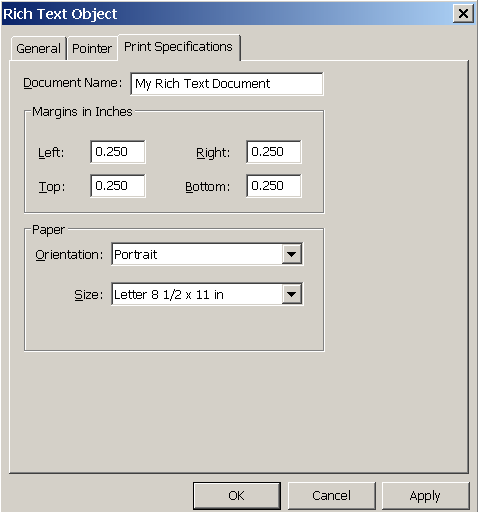The user can preview the layout and print the contents of the RichTextEdit control. In preview mode, users see a view of the document reduced so that it fits inside the control. If the control is small, the preview is tiny.
There are two ways to enter preview mode:
The user can press ctrl+f2 to switch between editing and preview mode
You can call the Preview function in a script:
rte_1.Preview(TRUE)
A user can adjust the margins of the preview mode by opening the property sheet for the RichTextEdit control to the Print Specifications tab and modifying the left, right, top, or bottom margins. Adjusting the margins in the Rich Text Object dialog box also affects the display of the RichTextEdit control content in standard view.

If the RichTextEdit is using DataWindow object data, you can limit the number of rows printed by setting the Print.Page.Range property for the DataWindow control. Its value is a string that lists the page numbers that you want to print. A dash indicates a range.
Example of a page range Suppose your RichTextEdit control has a data source in the control dw_source. Your rich text document is three pages and you want to print the information for rows 2 and 5. You can set the page range property before you print:
dw_source.Object.DataWindow.Print.Page.Range = & "4-6,13-15"
You can also filter or discard rows so that they are not printed.
For more information, see the SetFilter, Filter, RowsMove, and RowsDiscard functions in the PowerScript Reference and the Print DataWindow object property in the DataWindow Reference.
To print page numbers, you can use an input field in the header
or footer. Although
the page number field can be a string or numeric expression, when you
insert the page number field in a header or footer, you must use
it as a string expression only. For example, if you use page()*2 for
an input field in the header or footer, the control or report is
likely to display an incorrect result for the value of the numeric
expression. However, the following string expression should display
the correct page number and page count:
'Page ' + page() + ' of ' + pageCount())
This sample code sets the insertion point in the footer and inserts two blank lines, text, and two input fields:
rte_1.SelectText(1, 1, 0, 0, Footer!)
rte_1.ReplaceText("~r~n~r~nRow ")
rte_1.InputFieldInsert("row")
rte_1.ReplaceText(" Page ")
rte_1.InputFieldInsert("page")
rte_1.SetAlignment(Center!)